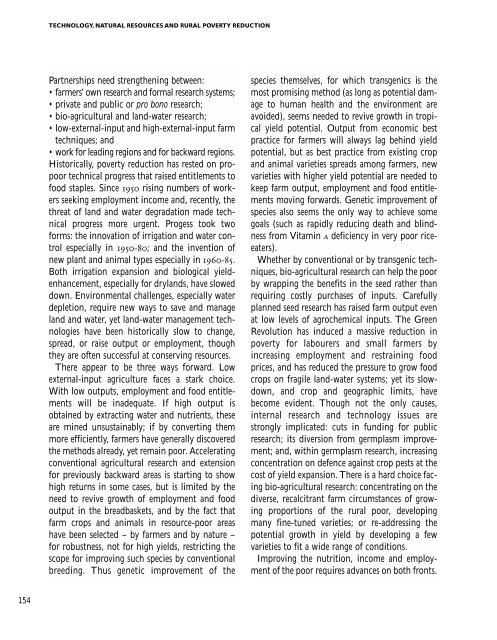English - IFAD
English - IFAD
English - IFAD
Create successful ePaper yourself
Turn your PDF publications into a flip-book with our unique Google optimized e-Paper software.
TECHNOLOGY, NATURAL RESOURCES AND RURAL POVERTY REDUCTION<br />
Partnerships need strengthening between:<br />
• farmers’ own research and formal research systems;<br />
• private and public or pro bono research;<br />
• bio-agricultural and land-water research;<br />
• low-external-input and high-external-input farm<br />
techniques; and<br />
• work for leading regions and for backward regions.<br />
Historically, poverty reduction has rested on propoor<br />
technical progress that raised entitlements to<br />
food staples. Since 1950 rising numbers of workers<br />
seeking employment income and, recently, the<br />
threat of land and water degradation made technical<br />
progress more urgent. Progess took two<br />
forms: the innovation of irrigation and water control<br />
especially in 1950-80; and the invention of<br />
new plant and animal types especially in 1960-85.<br />
Both irrigation expansion and biological yieldenhancement,<br />
especially for drylands, have slowed<br />
down. Environmental challenges, especially water<br />
depletion, require new ways to save and manage<br />
land and water, yet land-water management technologies<br />
have been historically slow to change,<br />
spread, or raise output or employment, though<br />
they are often successful at conserving resources.<br />
There appear to be three ways forward. Low<br />
external-input agriculture faces a stark choice.<br />
With low outputs, employment and food entitlements<br />
will be inadequate. If high output is<br />
obtained by extracting water and nutrients, these<br />
are mined unsustainably; if by converting them<br />
more efficiently, farmers have generally discovered<br />
the methods already, yet remain poor. Accelerating<br />
conventional agricultural research and extension<br />
for previously backward areas is starting to show<br />
high returns in some cases, but is limited by the<br />
need to revive growth of employment and food<br />
output in the breadbaskets, and by the fact that<br />
farm crops and animals in resource-poor areas<br />
have been selected – by farmers and by nature –<br />
for robustness, not for high yields, restricting the<br />
scope for improving such species by conventional<br />
breeding. Thus genetic improvement of the<br />
species themselves, for which transgenics is the<br />
most promising method (as long as potential damage<br />
to human health and the environment are<br />
avoided), seems needed to revive growth in tropical<br />
yield potential. Output from economic best<br />
practice for farmers will always lag behind yield<br />
potential, but as best practice from existing crop<br />
and animal varieties spreads among farmers, new<br />
varieties with higher yield potential are needed to<br />
keep farm output, employment and food entitlements<br />
moving forwards. Genetic improvement of<br />
species also seems the only way to achieve some<br />
goals (such as rapidly reducing death and blindness<br />
from Vitamin A deficiency in very poor riceeaters).<br />
Whether by conventional or by transgenic techniques,<br />
bio-agricultural research can help the poor<br />
by wrapping the benefits in the seed rather than<br />
requiring costly purchases of inputs. Carefully<br />
planned seed research has raised farm output even<br />
at low levels of agrochemical inputs. The Green<br />
Revolution has induced a massive reduction in<br />
poverty for labourers and small farmers by<br />
increasing employment and restraining food<br />
prices, and has reduced the pressure to grow food<br />
crops on fragile land-water systems; yet its slowdown,<br />
and crop and geographic limits, have<br />
become evident. Though not the only causes,<br />
internal research and technology issues are<br />
strongly implicated: cuts in funding for public<br />
research; its diversion from germplasm improvement;<br />
and, within germplasm research, increasing<br />
concentration on defence against crop pests at the<br />
cost of yield expansion. There is a hard choice facing<br />
bio-agricultural research: concentrating on the<br />
diverse, recalcitrant farm circumstances of growing<br />
proportions of the rural poor, developing<br />
many fine-tuned varieties; or re-addressing the<br />
potential growth in yield by developing a few<br />
varieties to fit a wide range of conditions.<br />
Improving the nutrition, income and employment<br />
of the poor requires advances on both fronts.<br />
154
















